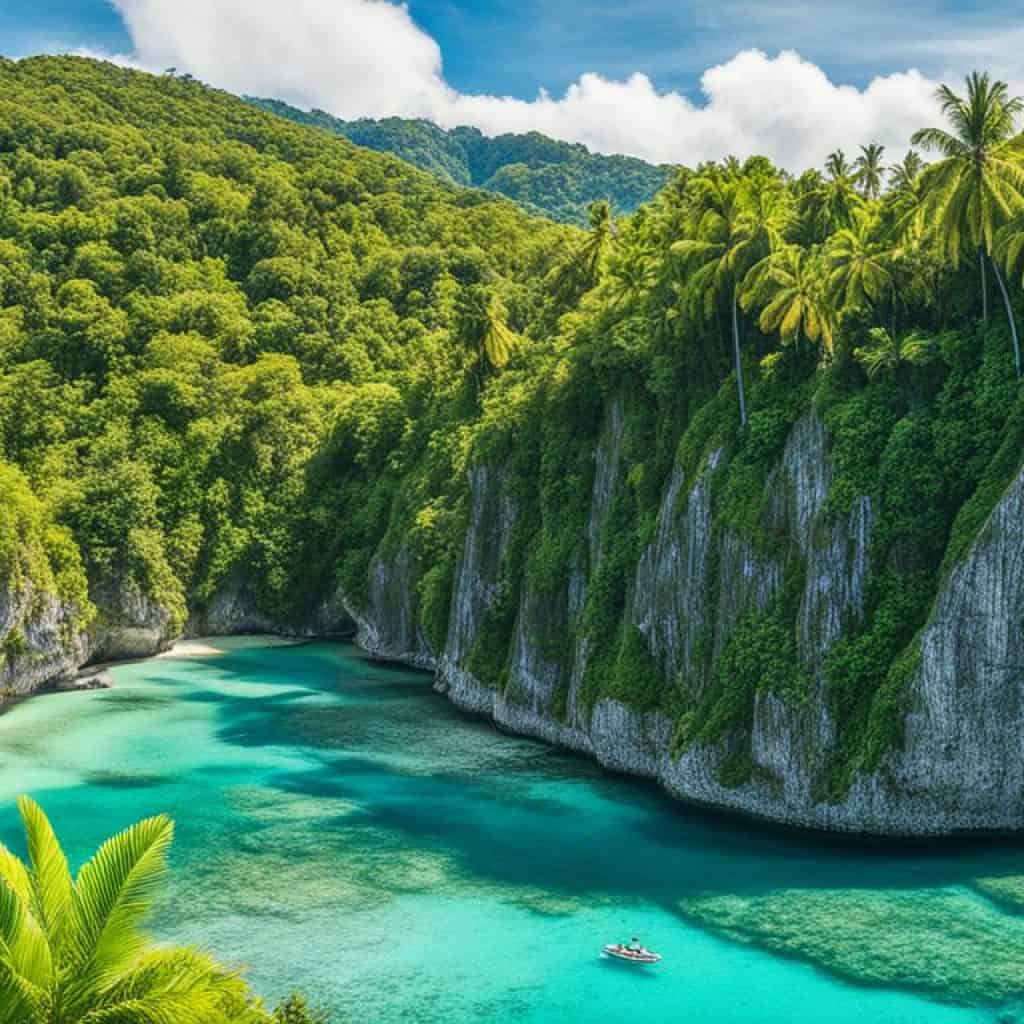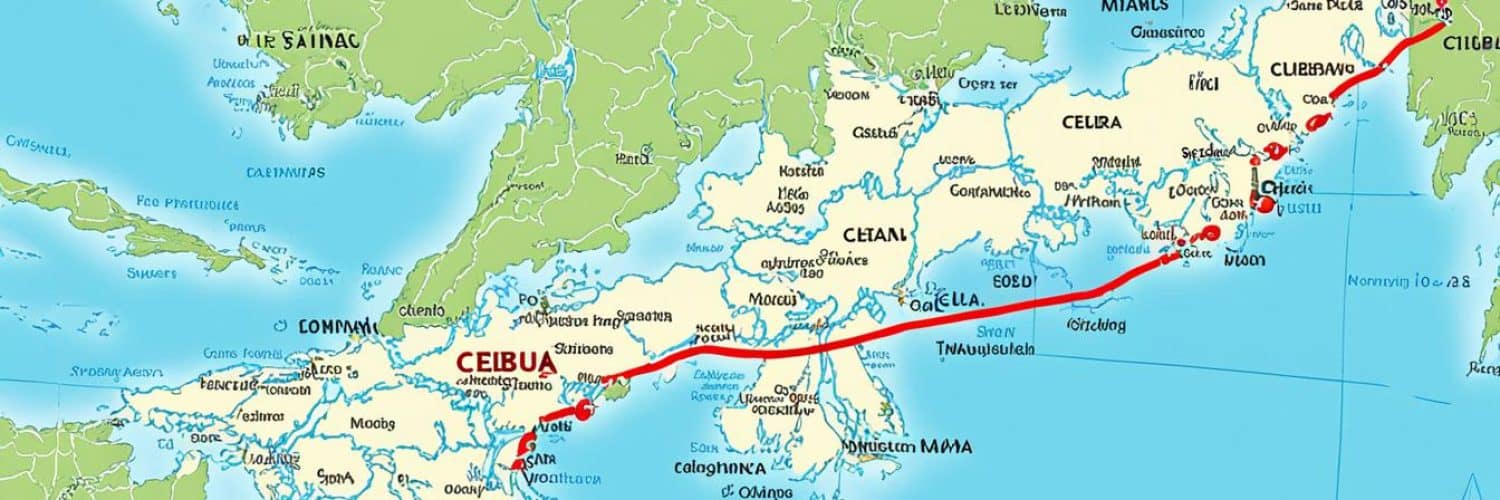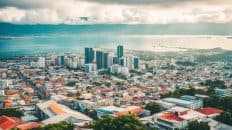Have you ever wondered where exactly Cebu is located on the Philippine map? This bustling province is renowned for its stunning beaches, rich history, and vibrant culture. But if you’ve ever struggled to find it on a map, you’re not alone.
When you think of popular tourist destinations in the Philippines, names like Boracay or Palawan might immediately come to mind. But Cebu, located in the Central Visayas region, is a hidden gem that deserves your attention.
So, how can you easily locate Cebu in the Philippine map? Is it tucked away in a remote corner or hidden in plain sight? Let’s delve into this and discover the exact location of Cebu on the map.
Key Takeaways:
- Cebu is a province located in the Central Visayas region of the Philippines.
- It is situated in the eastern coast of Cebu Island.
- Cebu City, the capital and largest city of the province, is located on the eastern coast of the island.
Overview of Cebu Province
Cebu Province is a captivating destination in the Philippines, renowned for its breathtaking beaches, fascinating history, and vibrant culture. Situated in the Central Visayas region, the province is composed of the main Cebu Island, along with 167 surrounding islands and islets. Let’s explore the beauty and charm that Cebu has to offer.
| Stunning Beaches | Rich History | Vibrant Culture |
|---|---|---|
|
|
|
Cebu Province’s administrative divisions include Cebu City, a vibrant municipality that offers a blend of urban conveniences and historical wonders. Cebu City is known for its iconic landmarks like Magellan’s Cross and Fort San Pedro.
“Cebu Province offers a diverse range of experiences, from relaxing on pristine beaches to delving into centuries of history.”
Whether you’re seeking adventure, relaxation, or cultural immersion, Cebu Province is an ideal destination. Stay tuned as we dive deeper into the enchanting attractions and hidden gems that await you in Cebu City, the heart of this captivating province.
Exploring Cebu City
Cebu City, the capital of Cebu Province, is a vibrant and bustling metropolis that offers a wide range of attractions for tourists. Whether you’re interested in exploring the city’s historical landmarks, indulging in the local cuisine, or simply soaking up the lively atmosphere, Cebu City has something for everyone.
One of the highlights of visiting Cebu City is discovering its rich history and cultural heritage. Take a stroll through the city and you’ll come across iconic landmarks such as Magellan’s Cross and Fort San Pedro. These historical sites offer a glimpse into the city’s colonial past and are a testament to its importance in Philippine history.
For those looking for a taste of the local cuisine, Cebu City is a food lover’s paradise. From mouthwatering street food to fancy restaurants, you’ll find a wide array of dining options to satisfy your cravings. Don’t miss out on trying the famous lechon, a delectable roasted pig that is a must-try when in Cebu.
Cebu City is also a great base for exploring the surrounding areas and tourist spots. Just a short drive away, you’ll find beautiful beaches where you can relax and soak up the sun. Some popular beach destinations include Mactan Island and Bantayan Island. If you’re a nature enthusiast, make sure to visit the stunning Kawasan Falls and Tumalog Falls, which offer breathtaking views and a refreshing swim.
Must-Visit Tourist Spots in Cebu City:
- Magellan’s Cross
- Fort San Pedro
- Basilica Minore del Santo Niño
- Taoist Temple
- Carbon Market
- SM Seaside City Cebu
- Lapu-Lapu Shrine
No visit to Cebu City is complete without experiencing its vibrant nightlife. The city offers a wide range of bars, clubs, and entertainment venues where you can dance the night away and have a great time.
“Cebu City is a vibrant mix of history, culture, and modernity. From its rich historical landmarks to its stunning natural wonders, there’s something for everyone to enjoy in this bustling metropolis.”
So whether you’re a history enthusiast, a food lover, or an adventure seeker, Cebu City should definitely be on your list of must-visit destinations. Explore the cebu city map, discover the top tourist spots, and immerse yourself in the vibrant culture of this enchanting city.
Discovering Cebu’s Natural Beauty
Located in the heart of the Philippines, Cebu Island is a treasure trove of natural beauty. With its diverse landscapes and stunning attractions, it offers a paradise for nature lovers and adventure seekers alike. From pristine white sandy beaches to majestic mountains and cascading waterfalls, there is something for everyone to enjoy in Cebu.
One of the must-visit destinations in Cebu is Osmeña Peak. As the highest point in the province, it offers breathtaking panoramic views of the surrounding islands and mountains. Hiking to the top of Osmeña Peak is a rewarding experience, allowing you to immerse yourself in the beauty of the Cebu landscape.
If you’re looking for a refreshing escape, look no further than Kawasan Falls. Located in the town of Badian, these picturesque waterfalls are a true natural wonder. Take a dip in the crystal-clear waters, unwind under the mesmerizing cascades, or go canyoneering for an adrenaline-pumping adventure. Kawasan Falls is a must-see destination that showcases the enchanting beauty of Cebu’s waterfalls.
For beach enthusiasts and diving enthusiasts, Malapascua Island is a true paradise. Renowned for its stunning white sand beaches and crystal-clear waters, it offers a tranquil getaway from the bustling city life. Dive into the vibrant coral reefs surrounding the island and swim with thresher sharks, the famous inhabitants of these waters. Malapascua Island is a hidden gem waiting to be discovered.

Explore the natural wonders of Cebu Island and immerse yourself in its breathtaking beauty. From the towering peaks to the pristine beaches, there is no shortage of attractions to discover. Whether you’re an avid hiker, a beach lover, or a nature enthusiast, Cebu has something to offer everyone.
Navigating Cebu’s Regions
Cebu Province is a diverse destination that offers a multitude of attractions spread across different regions. Each region within the province has its own distinct charm and appeal, making it an exciting place to explore. With a Cebu map showing the regions, visitors can easily plan their itinerary and navigate through the province’s various treasures.
Here are the four main regions of Cebu Province:
- Central Cebu: This region is home to the vibrant city of Cebu, a bustling urban center that offers a mix of historical landmarks, modern amenities, and a lively cultural scene. In Central Cebu, visitors can explore iconic attractions such as Magellan’s Cross, Fort San Pedro, and the lively streets of Colon and Mango Avenue.
- Northern Cebu: This region boasts stunning natural landscapes and beautiful coastal areas. Visitors can discover picturesque beaches, crystal-clear waters, and charming islands like Malapascua, Bantayan, and Carnaza. Nature lovers will also enjoy exploring the verdant mountains and waterfalls of Danao, Medellin, and Daanbantayan.
- Southern Cebu: This region is a paradise for outdoor enthusiasts and adventure seekers. It is known for its enchanting waterfalls, pristine diving spots, and breathtaking canyoneering experiences. Must-visit destinations in Southern Cebu include Kawasan Falls, Osmeña Peak, Moalboal, and the white sandbar of Sumilon Island.
- Eastern Cebu: This region is famous for its idyllic islands, stunning beaches, and rich marine life. Visitors can explore the beautiful islands of Mactan, Olango, and Camotes, where they can indulge in water sports, go island hopping, or simply unwind on powdery white sand beaches. The region is also home to fantastic dive sites, including San Vicente Marine Sanctuary and Pescador Island.
By understanding the different regions of Cebu Province and their unique offerings, visitors can make the most of their stay and create unforgettable memories. Whether you’re interested in urban adventures, natural wonders, or beachside bliss, Cebu has it all.
Historical Significance of Cebu
Cebu has a rich history that holds immense significance within the Philippines. As the oldest settlement in the country, it played a pivotal role in shaping its culture and heritage. One of the most notable events in Cebu’s history was the arrival of Portuguese explorer Ferdinand Magellan in 1521, marking the first circumnavigation of the globe. This historic moment took place on the shores of Cebu and forever changed the course of the Philippines.
Following Magellan’s expedition, Cebu City became the first Spanish settlement and Roman Catholic mission in the Philippines. The influence of Spanish colonization is still evident today, with numerous historical landmarks that symbolize the province’s past. These landmarks serve as a testament to Cebu’s historical significance and provide a glimpse into its vibrant heritage.
Magellan’s Cross
One of the most iconic historical landmarks in Cebu is Magellan’s Cross. Located in a small chapel near Basilica Minore del Santo Niño, this cross is believed to have been planted by Ferdinand Magellan himself upon his arrival in Cebu. It has become a symbol of Cebu’s conversion to Christianity and is revered by locals and tourists alike.
Magellan’s Cross, a symbol of Cebu’s conversion to Christianity.
Basilica Minore del Santo Niño
Basilica Minore del Santo Niño is a significant religious site in Cebu City. It houses the revered Santo Niño de Cebu, a statue depicting the child Jesus. The basilica is not only a place of worship but also a historical landmark that showcases the fusion of Spanish and Filipino influences in its architecture.
Fort San Pedro
Fort San Pedro is a well-preserved military defense structure that was built during the Spanish colonial period. It served as a stronghold against attacks and intrusions, reflecting Cebu’s strategic importance during that time. Today, the fortress stands as a living testament to Cebu’s colonial heritage and offers visitors a glimpse into its historical significance.
Economic Importance of Cebu City
Cebu City, located in the beautiful province of Cebu, Philippines, is not only a popular tourist destination but also a vital contributor to the country’s economy. With its strategic location and robust industries, Cebu City plays a significant role in the economic development of the Philippines.
The city serves as a major commercial and industrial hub, attracting businesses from various sectors. Cebu City is home to a diverse range of industries, including manufacturing, processing, and business process outsourcing (BPO). These industries provide employment opportunities for local residents and contribute to the city’s economic growth.
Cebu City acts as a collection center for interisland commodities, such as copra, abaca, sugar, timber, and fish. These valuable resources are collected and distributed to other parts of the country, supporting the agricultural and maritime sectors.
Besides its role in these traditional industries, Cebu City has also emerged as a prominent player in the BPO sector. The city is recognized as one of the top destinations for outsourcing services, with numerous multinational companies establishing operations in the area. The BPO industry not only generates employment but also boosts the local economy through increased spending and investment.
Furthermore, Cebu City’s thriving tourism industry contributes significantly to its economic vitality. The city’s stunning beaches, historical landmarks, and vibrant culture attract tourists from around the globe, creating jobs and driving revenue for local businesses.
To showcase the economic importance of Cebu City, here is a table highlighting some key industries and their contributions:
| Industry | Contribution |
|---|---|
| Manufacturing | Production of textiles, footwear, processed foods, and furniture |
| Business Process Outsourcing | Employment and revenue generation in the outsourcing sector |
| Tourism | Job creation and increased revenue from tourist activities |
| Agriculture | Collection and distribution of agricultural commodities |
Cebu City’s thriving economy and vibrant industries make it a significant contributor to the overall development of the Philippines. Its strategic location, diverse sectors, and strong business environment continue to attract investments and opportunities for growth, making it a key player in the country’s economic landscape.
Education and Culture in Cebu City
Cebu City is a vibrant hub of education and culture in the Philippines. The city is home to several esteemed universities, including the University of San Carlos, Cebu Institute of Technology, and University of the Southern Philippines. These institutions provide a wide range of academic programs and opportunities for students to pursue their passions and gain knowledge in various fields.
At the University of San Carlos, students have access to a diverse range of disciplines, including business, engineering, health sciences, and the humanities. The university’s commitment to academic excellence and research is evident in its faculty and state-of-the-art facilities, ensuring a well-rounded education for its students.
The Cebu Institute of Technology, on the other hand, is renowned for its engineering and technology programs. It offers specialized courses in areas such as computer science, civil engineering, and electronic engineering that prepare students for careers in the ever-evolving tech industry.
The University of the Southern Philippines is a prominent institution known for its programs in law, medicine, and business administration. With a focus on holistic development, the university nurtures students to become responsible and ethical professionals in their chosen fields.
In addition to these universities, Cebu City also boasts a vibrant cultural scene. The city is a melting pot of diverse influences, reflected in its festivals, art exhibits, and musical performances. One such festival is the Sinulog Festival, which celebrates the city’s rich history and cultural heritage. During the festival, the streets come alive with colorful processions, traditional dances, and grand performances that showcase Cebuano culture at its finest.
“Cebu City is not only a center of learning but also a haven for cultural enthusiasts. The city’s art galleries and museums offer a glimpse into the local art scene, showcasing the works of talented Cebuano artists. From contemporary art to traditional crafts, visitors can immerse themselves in the vibrant cultural tapestry of the city.”
Whether you’re a student seeking quality education or a culture lover in search of artistic inspiration, Cebu City has much to offer. Its universities provide excellent academic programs, while its cultural scene offers a rich tapestry of traditions and expressions. Explore the city’s educational institutions and immerse yourself in its vibrant cultural offerings.
Transportation in Cebu City
Cebu City boasts a well-developed transportation system, providing convenient options for visitors to explore the city and its surroundings. Whether you’re arriving at Mactan-Cebu International Airport or planning to navigate the city streets, there are various modes of transportation available to make your journey seamless.
Taxis
One of the most convenient ways to get around Cebu City is by taxi. Taxis are readily available and can be found at designated taxi stands or hailed on the street. They are metered, ensuring transparency and fair pricing. Taxis are a popular choice for travelers who prefer privacy and comfort.
Buses
For budget-conscious travelers, buses offer an affordable and reliable mode of transportation. Cebu City has a comprehensive bus network that covers major routes within the city and beyond. Buses are a great option for exploring different parts of the city and reaching popular tourist destinations.
Jeepneys
A uniquely Filipino mode of transportation, jeepneys are a common sight on the streets of Cebu City. These vibrant and colorful vehicles offer a fun and affordable way to navigate the city. Jeepneys follow specific routes and can be flagged down along the roadside. They are an iconic symbol of Philippine culture and a must-try experience for visitors.
Mactan-Cebu International Airport
For travelers arriving by air, Mactan-Cebu International Airport serves as the main gateway to Cebu City. Located on Mactan Island, just a short distance from the city center, the airport offers domestic and international flights. It is well-connected to various destinations, making it convenient for travelers from around the world.
| Transportation Mode | Advantages | Disadvantages |
|---|---|---|
| Taxis | – Convenient and private – Metered fares |
– May be more expensive than other options – Traffic congestion during peak hours |
| Buses | – Affordable fares – Comprehensive network |
– Crowded during peak hours – Limited schedules for certain routes |
| Jeepneys | – Authentic cultural experience – Affordable fares |
– Can be crowded – Routes may not be clearly marked |
With its well-connected transportation system, including taxis, buses, jeepneys, and the convenience of Mactan-Cebu International Airport, exploring Cebu City and its surrounding areas has never been easier. Whether you’re a first-time visitor or a seasoned traveler, you’ll find plenty of options to get around and discover the vibrant city.
Urban Development in Cebu City
Cebu City, the bustling capital of Cebu Province, has witnessed remarkable urban development in recent years. The city’s skyline is now adorned with modern high-rise buildings, a testament to its growth and progress. These towering structures reflect the city’s thriving economy and bustling urban landscape.
The urban areas of Cebu City are primarily concentrated near the main business district and the bustling port area. These strategic locations serve as hubs for commercial activities, trade, and transportation, driving the city’s economic growth and attracting both local and international investments.
However, rapid urbanization comes with its own set of challenges. The influx of population due to the city’s development has led to increased demand for housing, creating a shortage in certain areas. Efforts are underway to address this issue and provide adequate housing for the growing population.
Despite these challenges, Cebu City continues to be a prime destination for business, tourism, and investment. Its impressive skyline stands as a symbol of progress and prosperity, attracting visitors from all corners of the globe. The city’s vibrant and dynamic atmosphere, coupled with its rich cultural heritage, make it a captivating destination for both residents and tourists alike.
“Cebu City’s urban development is a testament to its growing economic importance and the city’s ability to adapt and thrive in a dynamic global landscape.” – Mayor John Gomez
To catch a glimpse of Cebu City’s remarkable urban development and experience the vibrant energy it exudes, explore the city’s bustling streets and immerse yourself in its rich tapestry of cultures, traditions, and opportunities.
Key Features of Cebu City’s Urban Development
- Modern high-rise buildings
- Strategic urban areas near the business district and port
- Influx of population
- Housing shortage in certain areas
- Continued economic growth and prosperity
Major Developments in Cebu City
| Development Project | Description | Completion Date |
|---|---|---|
| Ayala Center Cebu | A premier shopping, dining, and entertainment complex. | 2005 |
| IT Park | A hub for information technology and business process outsourcing companies. | 2006 |
| Cebu Business Park | A mixed-use development consisting of commercial, residential, and recreational spaces. | 1990 |
| Cebu-Cordova Link Expressway | A bridge connecting Cebu City and Cordova Municipality, improving transportation and connectivity. | 2022 (upcoming) |
Through careful urban planning and sustainable development initiatives, Cebu City continues to shape its urban landscape while preserving its cultural heritage and natural beauty. The city’s skyline serves as a reminder of its progress and serves as an invitation for visitors to explore and experience the vibrant heart of Cebu Province.
Economy and Industries in Cebu Province
Cebu Province’s economy is diverse and dynamic, contributing significantly to the overall economic growth of the Philippines. The province serves as a major hub for various industries, creating employment opportunities and driving development in the region.
One of the primary sectors in Cebu Province’s economy is manufacturing. The province is known for its thriving textile, footwear, furniture, and chemicals industries. These sectors contribute to both local and international markets, showcasing Cebu Province’s manufacturing prowess.
Moreover, Cebu Province is renowned for its exports. It is a leading producer of copra, abaca, sugar, and fish, which are exported to different parts of the world. These exports not only generate revenue but also contribute to the region’s overall economic stability.
“Cebu Province’s economic landscape is a testament to its ability to attract investments in various sectors.”
The business process outsourcing (BPO) industry is also thriving in Cebu Province. Many global companies have set up BPO centers in the province, creating job opportunities and boosting the local economy. The BPO industry in Cebu Province offers services in customer support, IT outsourcing, and other related fields.
The tourism sector also plays a significant role in Cebu Province’s economy. The province attracts a large number of domestic and international tourists who come to explore its natural beauty and cultural heritage. The tourism industry creates employment opportunities in hospitality, transportation, and other related sectors.
To further support economic growth, Cebu Province has also attracted investments in heavy industries such as power generation and construction. These industries contribute to the overall infrastructure development of the province and enhance its capacity to meet the demands of businesses and residents alike.
Key Highlights:
- Cebu Province’s economy is characterized by diverse industries.
- The province excels in manufacturing sectors such as textiles, footwear, furniture, and chemicals.
- Cebu Province is known for its exports of copra, abaca, sugar, and fish.
- The business process outsourcing (BPO) industry is thriving in Cebu Province.
- Tourism plays a significant role in the province’s economy.
- Investments in heavy industries contribute to infrastructural development in the province.
Cebu Province’s robust economy and various industries make it a key player in the economic development of the Philippines. With a diverse range of sectors and investment opportunities, the province continues to attract investors and contribute to the overall growth of the country.
Infrastructure and Connectivity in Cebu Province
Cebu Province boasts a well-developed infrastructure and connectivity that makes it a highly accessible destination. The province is easily reachable from all points on Cebu Island, thanks to its extensive network of highways and a coastal railway system. These transportation routes connect different parts of the province, providing convenient travel options for both locals and tourists.
The province is also served by ports and shipping terminals, facilitating the efficient transportation of goods. This well-established maritime infrastructure ensures that Cebu Province remains an important hub for trade and commerce in the Philippines. Whether it’s the import and export of various commodities or the distribution of goods to different areas, the province’s transportation infrastructure plays a vital role in its economic development.
Mactan-Cebu International Airport serves as a major transportation hub for the province. Situated on Mactan Island, the airport connects Cebu Province to various domestic and international destinations. With numerous airlines operating flights to and from Cebu, travelers have convenient access to the province and can easily explore its natural wonders, historical sites, and vibrant cities.
Coastal Railway System
One of the highlights of Cebu Province’s transportation infrastructure is its coastal railway system. This railway provides a scenic and convenient mode of transportation for both commuters and tourists. Traveling along the picturesque coast, the railway offers breathtaking views of the sea and the surrounding landscapes.
“The coastal railway system in Cebu Province not only enhances connectivity but also allows passengers to experience the province’s natural beauty while traveling.”
Ports and Shipping Terminals
The ports and shipping terminals in Cebu Province are crucial components of its transportation infrastructure. They serve as important gateways for the movement of goods within the province and beyond. These facilities enable efficient logistics and contribute to the province’s economic development by facilitating trade and commerce.
Mactan-Cebu International Airport
Mactan-Cebu International Airport is a vital transportation hub for Cebu Province. It connects the province to domestic and international destinations, making it easily accessible for travelers from around the world. The airport offers a wide range of flights, providing convenient options for both leisure and business travelers.
Cultural Heritage in Cebu Province
Cebu Province is a treasure trove of cultural heritage sites and landmarks that offer a glimpse into its storied past. From majestic Spanish-era churches to well-preserved ancestral houses, visitors can immerse themselves in the rich history and diverse cultural traditions of the province.
One of the notable landmarks in Cebu Province is the Magellan Shrine, located in Lapu-Lapu City. This monument commemorates the Battle of Mactan, which took place in 1521 and marked the first recorded resistance of Filipinos against foreign colonization. It serves as a reminder of the bravery and heroism of Lapu-Lapu, a local chieftain who led his troops to victory against Portuguese explorer Ferdinand Magellan.
“The Magellan Shrine stands as a symbol of our nation’s fight for independence and the pride we take in our cultural heritage.” – Mayor of Lapu-Lapu City
Another cultural highlight in Cebu Province is the annual Sinulog Festival, a colorful and vibrant celebration held every January in Cebu City. This religious and cultural event pays homage to the Santo Niño, the patron saint of Cebu. The festival features street parades, dance performances, and traditional music, attracting both locals and tourists from around the world.
Aside from these renowned landmarks and festivals, Cebu Province also boasts a wealth of archaeological sites, museum galleries, and cultural centers that delve deeper into its past. Visitors can explore the Cebu Provincial Museum, which showcases artifacts and exhibits that tell the story of the province’s history and cultural heritage.
Whether you’re exploring the Spanish-influenced architecture of old churches or immersing yourself in the vibrant festivals that celebrate Cebu’s rich cultural traditions, the province’s cultural heritage offers a fascinating journey through time.
Natural Attractions in Cebu Province
Cebu Province in the Philippines is a treasure trove of natural attractions, offering visitors an array of breathtaking landscapes and outdoor adventures. From the pristine white sand beaches of Bantayan Island and Moalboal to the enchanting waterfalls of Kawasan Falls and Tumalog Falls, there is no shortage of scenic spots to explore.

One of the highlights of Cebu Province is Bantayan Island, known for its crystal-clear turquoise waters and powdery white sand beaches. Visitors can soak up the sun, go snorkeling or diving, and indulge in fresh seafood delicacies.
Kawasan Falls, located in the town of Badian, is a natural oasis tucked away in the lush mountains of Cebu. Its cascading turquoise waters surrounded by dense foliage create a serene and picturesque setting, perfect for swimming, canyoneering, and tubing adventures.
“Cebu Province is a haven for nature lovers, with its stunning beaches, waterfalls, and diverse landscapes. Exploring the natural attractions of Cebu is like stepping into paradise.” – Local Travel Enthusiast
Tumalog Falls, also known as “the hidden treasure of Oslob,” is a must-visit destination in Cebu. Its ethereal beauty, with water cascading down like a curtain, mesmerizes visitors. This enchanting waterfall offers a refreshing respite and unique photo opportunities.
Pescador Island, located off the coast of Moalboal, is a diver’s paradise. It offers vibrant coral reefs, a rich marine ecosystem, and the chance to swim with majestic sea turtles and sardine shoals. Snorkelers and divers can explore the underwater wonders and witness the breathtaking biodiversity of Cebu’s waters.
Discover the Natural Marvels of Cebu Province
Cebu Province’s natural attractions showcase the stunning landscapes and rich biodiversity that make it a paradise for nature enthusiasts and adventure seekers alike. Whether you’re looking to relax on pristine beaches, chase waterfalls, or explore the underwater world, Cebu has something to offer.
So pack your bags, grab your camera, and immerse yourself in the natural wonders of Cebu Province.
Conclusion
Cebu Province is a true tropical paradise that offers a mix of stunning landscapes, rich history, and vibrant culture. Whether you’re seeking relaxation on pristine beaches, thrilling adventures in crystal-clear waters, or a dive into the province’s fascinating heritage, Cebu has something to offer every type of traveler.
Don’t forget to use the convenient map outline to locate Cebu on the Philippine map and plan your unforgettable journey to this marvelous destination. Explore the beautiful landscapes, soak up the sun on the breathtaking beaches, and immerse yourself in the local traditions and charm that make Cebu a must-visit place.
With its diverse attractions, Cebu Province captivates visitors from all over the world. Whether you’re hiking to the top of Osmeña Peak or discovering the underwater wonders around Pescador Island, every moment spent exploring Cebu will leave you with lasting memories. So pack your bags, unleash your wanderlust, and embark on an adventure in this tropical paradise known as Cebu Province.


















Add comment